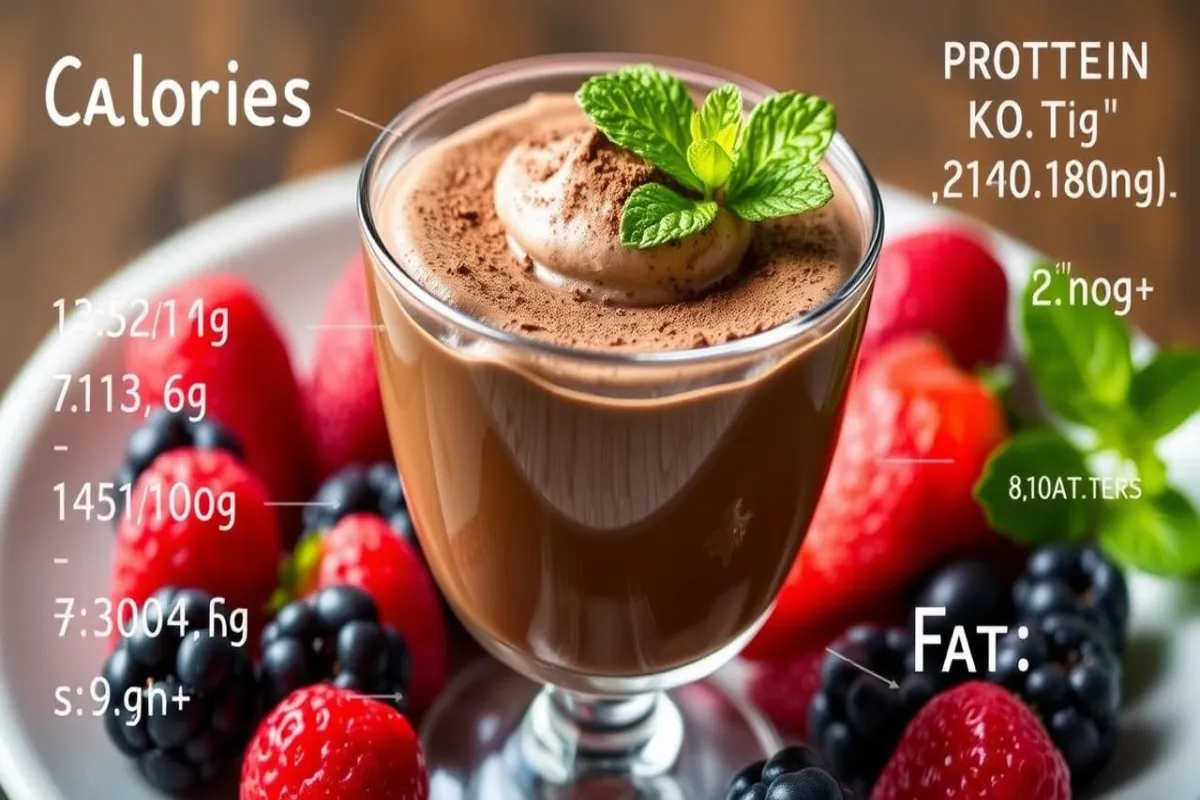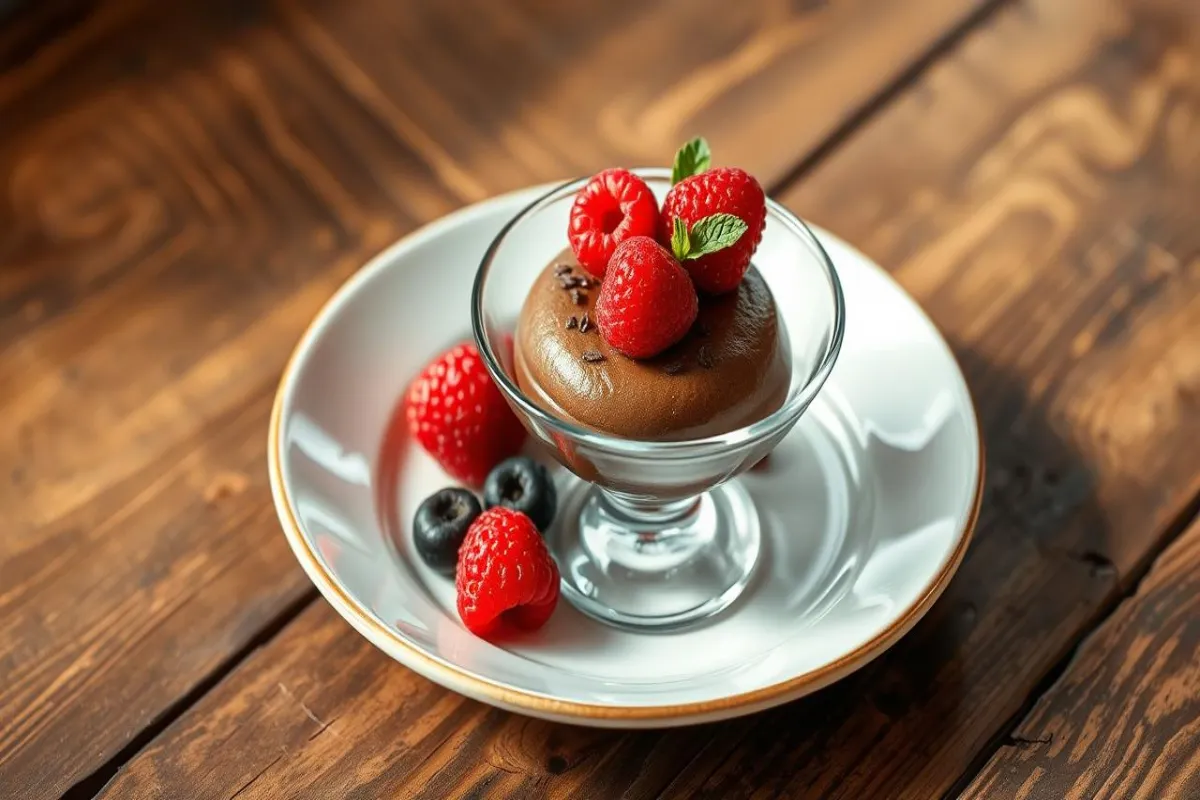Indulging in chocolate mousse is a treat for many. But how much should you eat? Knowing the right serving size is key to enjoying it without overdoing it. Chocolate mousse is not just tasty; it’s also about balance.
Many think a serving is a big spoonful or a large portion. But, the truth is, a standard serving is about 1/2 cup or 202 grams. This size meets your chocolate craving while keeping your diet balanced.
What Is Chocolate Mousse?
Definition and Brief History
Chocolate mousse is a rich and creamy dessert that has been enjoyed for centuries. It’s typically made with melted chocolate, eggs, cream, and sometimes additional flavorings like vanilla or liqueur. The French word “mousse” means foam, representing the light and airy texture of this dessert.
Since the 19th century, chocolate mousse has remained a favorite in French cuisine and beyond. For those who love no-bake desserts, you might also love this No-Bake Cheesecake Filling recipe for an easy and delicious alternative.
Standard Serving Size
The standard serving size of chocolate mousse is typically around 1/2 cup or 202 grams. This serving size offers a balance of indulgence without going overboard. A typical serving contains around 455 calories, made up of fat, protein, and carbs. For more on indulgent desserts, you can check out the Snickers Strawberry Cheesecake Recipe for another layered dessert treat.
A typical serving of chocolate mousse has 455 calories. It’s made up of 8% protein, 28% carbs, and 64% fat. It also has a lot of cholesterol and saturated fat, but not much sodium or fiber. So, it’s best to enjoy it in small amounts.

While the standard serving size is a good guide, listen to your body and diet needs. Enjoying homemade or restaurant chocolate mousse in moderation is key. This way, you can enjoy its delicious taste without upsetting your diet balance.
How Much Is a Serving of Chocolate Mousse?
Typical Portion Sizes and Nutrition Information
Chocolate mousse is known for its generous servings. A typical 1/2 cup (202 grams) has about 455 calories. It’s also packed with 32.3 grams of fat, 8.4 grams of protein, and 32.5 grams of carbs.
The nutrition facts highlight its rich, indulgent nature. A 1/2 cup serving has 41% of the daily fat value. It includes 18.5 grams of saturated fat, which is 92% of the daily limit. Cholesterol levels are also high, reaching 94% of the daily value in a 1/2 cup portion.
Despite its high calorie and fat content, chocolate mousse has some nutritional benefits. It provides 15% of the daily calcium intake and 6% of iron and potassium. Its low glycemic index of 21 means it has a minimal effect on blood sugar levels.

The exact nutritional breakdown can vary based on the recipe and ingredients. However, a 1/2 cup serving is a rich treat that should be enjoyed in moderation. It’s best to have it as part of a balanced diet.
Variations in Serving Sizes
The size of a chocolate mousse serving can change a lot. Restaurants often give bigger portions, from 1/2 cup to 1 cup or more. They want to make sure you enjoy a rich dessert.
But homemade chocolate mousse is usually smaller. It’s about 1/4 cup to 1/2 cup per serving. This helps you keep your portions in check and avoid eating too much.
These size differences can affect how many calories you get. It’s important to know this when you’re deciding what to eat.
Restaurant Portions vs. Homemade
At a restaurant, one serving of chocolate mousse can have 400 to 800 calories or more. This is because it’s so creamy and rich, and restaurants give you more.
But making chocolate mousse at home is different. You can get 6 servings, with each one about 130 calories. This way, you can still enjoy a delicious treat but watch your calorie intake better.
Factors Affecting Serving Size
The size of a chocolate mousse serving can change based on several things. These include the recipe, the chocolate type and amount, and personal taste. Recipes with more cream or egg yolks tend to be richer and more decadent. This richness often means smaller servings.
Most chocolate mousse recipes use 70% cocoa dark chocolate. This gives a strong chocolate taste and less sweetness. Bittersweet dark chocolate with 70% cocoa is best for a richer taste. Quality bittersweet dark chocolate can cost over $20 per kilogram.
On the other hand, lighter textures or less chocolate can lead to bigger servings. Personal preferences and how much you want to eat also affect serving sizes. These are key factors that affect chocolate mousse serving size and what determines chocolate mousse portion size.
Research indicates that chocolate mousse recipes often use 3 eggs. These eggs are raw and crucial for the mousse’s fluffy yet creamy texture. The recipe also calls for full-fat cream, like pure or heavy cream, for whipping.
Making the mousse takes about 20 minutes. It needs at least 6 hours in the fridge, best overnight, to set. Each of the 4 servings is 1/2 cup (125ml) and has about 375 calories.
Nutritional Value of a Serving
A serving of chocolate mousse has about 455 calories in 1/2 cup (202 grams). It has 32.3 grams of fat, 32.5 grams of carbs, and 8.4 grams of protein. It also has calcium, iron, vitamin A, and vitamin B12.
Calories, Macronutrients, and Micronutrients
In a 1/2 cup (202 gram) serving, you get 455 calories. There are 32.3 grams of fat, 32.5 grams of carbs, and 8.4 grams of protein. It also has 96.0 mg of calcium and 0.6 mg of iron.
It has 509.0 IU of vitamin A and 0.5 μg of vitamin B12. But the exact values can change based on the recipe and ingredients.
Tips for Portion Control
To keep your diet balanced and healthy, it’s key to control your portions when eating chocolate mousse. This rich treat can be enjoyed in moderation with a few simple steps. You can enjoy its delicious flavors without overdoing it.
Start by serving chocolate mousse in small ramekins or shot glasses. This makes it easier to keep track of how much you’re eating. You can also share a serving with someone, making it a fun treat for two.
Adding fresh fruit or a light dessert to your chocolate mousse can balance its richness. This way, you can still satisfy your sweet cravings while adding more nutrients to your meal.
Listen to your body’s hunger and fullness signals. Stop eating when you feel full, even if there’s more mousse. Enjoying chocolate mousse as an occasional treat helps keep it special and healthy.
By using these tips for eating chocolate mousse in moderation and controlling the portion size, you can enjoy its unique flavors. This way, you can keep your diet healthy and balanced.
Chocolate Mousse Recipes
Chocolate mousse is a delicious dessert with many flavors. The classic recipe mixes dark chocolate, eggs, heavy cream, and sugar. It’s a rich and creamy treat.
Classic and Unique Flavor Combinations
The classic chocolate mousse is loved by many. But there are also many creative versions. You can find dark chocolate, white chocolate, mocha, raspberry, mint, and salted caramel mousse.
These unique recipes add a twist to the classic. You can choose from dark chocolate’s intensity to white chocolate’s sweetness. There’s a recipe for every taste.
Chocolate mousse has about 415 calories per serving. It has 31 grams of fat and 5 grams of protein. It makes 8 servings and takes 2 hours and 30 minutes to prepare, including chilling.
Alternatives to Traditional Chocolate Mousse
Chocolate mousse is a favorite dessert, but some like lighter or healthier choices. Luckily, there are many alternatives with a unique twist. Avocado chocolate mousse is creamy and dairy-free, made with avocado, cocoa powder, and sweetener. It’s rich and smooth, yet low in calories.
Tofu chocolate mousse is great for those wanting protein. It’s vegan, using silken tofu, chocolate, and plant-based ingredients. It’s a guilt-free treat. Greek yogurt chocolate mousse is also a good choice, with its tangy flavor and high protein.
Chia seed chocolate mousse is a nutritious option, with a pudding-like texture. Chia seeds add fiber, omega-3s, and antioxidants. The cocoa powder and plant-based milk give it a rich chocolate taste. These non-traditional chocolate mousse recipes are tasty and healthy chocolate mousse options for a guilt-free treat.
FAQ
What is the standard serving size for chocolate mousse?
The standard serving size for chocolate mousse is about 1/2 cup, or 202 grams.
What is the definition and brief history of chocolate mousse?
Chocolate mousse is a rich dessert made with chocolate, eggs, and cream. It may also include sugar, vanilla, and liqueur. The name “mousse” means “foam” in French, which suits its light texture. It has been loved since the 19th century, with many recipes and variations.
What is the typical nutritional information for a serving of chocolate mousse?
A 1/2 cup (202 grams) serving of chocolate mousse has about 455 calories. It has 32.3 grams of fat, 8.4 grams of protein, and 32.5 grams of carbs. It’s also rich in vitamins and minerals like calcium, iron, and vitamin A.
How do restaurant portions compare to homemade portions of chocolate mousse?
Restaurants often serve more chocolate mousse, up to 1 cup or more. They want to give a big treat. Homemade mousse is usually 1/4 cup to 1/2 cup. This helps control how much you eat.
What factors can influence the serving size of chocolate mousse?
Many things can change how much chocolate mousse you serve. The recipe, the chocolate type, and added ingredients matter. Recipes with more chocolate or ingredients can make smaller servings.
What are some tips for enjoying chocolate mousse in moderation?
To enjoy chocolate mousse without overdoing it, use small ramekins or shot glasses. Share a serving with someone. Pair it with fruit or a light dessert. Listen to your body’s hunger and fullness signals. Treat it as an occasional delight, not a daily snack.
What are some alternative and healthier versions of chocolate mousse?
There are healthier chocolate mousse options like avocado, tofu, Greek yogurt, and chia seed versions. These use plant-based or dairy-free ingredients. They offer a creamy texture without the high calories and fat of traditional mousse.
Conclusion
Chocolate mousse is a rich and indulgent dessert. It’s usually served in 1/2 cup (202 gram) portions. This size balances the creamy flavors and keeps portions in check.
The serving size can change based on the recipe, chocolate type, and if it’s homemade or from a restaurant. Knowing the summary of chocolate mousse serving size and nutritional info helps make better choices. Enjoying it in moderation as part of a balanced diet lets dessert lovers enjoy the flavors without harming their health.
The key takeaways about chocolate mousse portions are about portion control and recipe variations. It’s also important to consider where the mousse comes from. With this knowledge, people can enjoy the creamy, chocolatey goodness of chocolate mousse while staying healthy and sustainable in their dessert choices.
